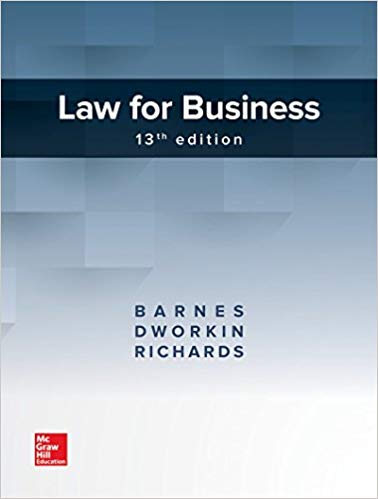Question
Need this case briefed. Please refer to image below for how a case is briefed. Davis V. Dyson Facts From 1998 through 2003, Joe Dyson

Need this case briefed. Please refer to image below for how a case is briefed.
Davis V. Dyson
Facts From 1998 through 2003, Joe Dyson and others served on the board of the Granville Homeowner's Association. Larson Property Management, Inc. (LPI) served as the property manager for Granville. Warren Larson, LPI's principal, embezzled $550,000 from the association by forging the signature of Anna Skalka, the director who served as the treasurer for the association, on 100 association checks.
During this period, the directors never reviewed the bank statements for the association, nor did they order any type of audit or even a financial review. The embezzlement was not discovered until July 2003 when the on-site manager looked at just one of the bank statements. To add insult and injury to embezzlement, the association did not have a bond covering the Larson crowd. To add outrage to insult, injury, and embezzlement, the directors never sought legal counsel regarding their duties, processes, and responsibilities.
To add expenses to the outrage, insult, injury, and embezzlement, the association had to fork over between $200,000 and $250,000 to pay legal and accounting fees for the investigation to determine exactly how much had been pilfered. The board did obtain $60,000 from an insurer and $4,000 from the bank, but the total uncompensated loss still exceeded $800,000.
Evelyn Davis and other homeowners (plaintiffs) brought suit against former board members (defendants) of the Association. The homeowners sought damages as individuals as well as on a derivative basis and for breach of the business judgment rule. The trial court dismissed the claims, and the homeowners appealed.
Judicial Opinion Gordon, Justice A fiduciary relationship is a relationship in which "there is special confidence in one who, in equity and good conscience, is bound to act in good faith with due regard to the interests of the other."
As part of this fiduciary duty, directors are required to comply with procedures in the condominium bylaws as well as the strictures of the condo act.
[I]n the case at hand, plaintiffs allege that the director defendants have violated the condo act and the Association's bylaws by failing to purchase the required insurance to protect the Association against fraud such as was allegedly committed by Larson. [S]uch allegations constitute a valid cause of action for breach of fiduciary duty.
[I]n the instant case [plaintiffs] have sufficiently alleged a violation of fiduciary duty on the part of the director defendants to survive a motion to dismiss on the pleadings.
Plaintiffs argue that defendants, as former directors, cannot assert the business judgment rule in their defense to bar the current suit. The business judgment rule does not apply where defendants have committed a breach of care, as is alleged in the complaint.
Under the business judgment rule, "[a]bsent evidence of bad faith, fraud, illegality or gross over reaching, courts are not at liberty to interfere with the exercise of business judgment by corporate directors." The purpose of this rule is to protect directors who have been diligent and careful in performing their duties from being subjected to liability from honest mistakes of judgment. However, it is a prerequisite to the application of the business judgment rule that the directors exercise due care in carrying out their corporate duties. If directors fail to exercise due care, then they may not use the business judgment rule as a shield for their conduct.
One component of due care is that directors must inform themselves of material facts necessary for them to properly exercise their business judgment. Thus, the business judgment rule is defeated where directors act without "becoming sufficiently informed to make an independent business decision."
... [P]laintiffs allege in their complaint that none of the director defendants reviewed any of the Association's monthly bank statements, which would have enabled them to uncover Larson's embezzlement. Plaintiffs further allege that the director defendants never obtained advice of counsel to learn about their duties regarding insurance coverage, Association finances, or supervision of key personnel. These allegations, when viewed in the light most favorable to plaintiffs could potentially support a finding that the director defendants breached their duty of due care. The "inexcusable unawareness or inattention" is alleged here in the present case.
In addition, plaintiffs allege that the director defendants violated the condo act through their failure to purchase proper insurance to protect Association funds. Illegality is one factor that can render directors unable to avail themselves of the protection of the business judgment rule. This is consistent with the general rule of tort law that violation of a statute designed to protect property is prima facie evidence of negligence, which, as discussed above, renders the business judgment rule inapplicable. Therefore, plaintiffs have sufficiently alleged a breach of due care, such that the business judgment rule does not apply to bar plaintiffs' suit at the pleading stage.
Affirmed in part, reversed in part, and remanded.

Step by Step Solution
There are 3 Steps involved in it
Step: 1

Get Instant Access to Expert-Tailored Solutions
See step-by-step solutions with expert insights and AI powered tools for academic success
Step: 2

Step: 3

Ace Your Homework with AI
Get the answers you need in no time with our AI-driven, step-by-step assistance
Get Started


